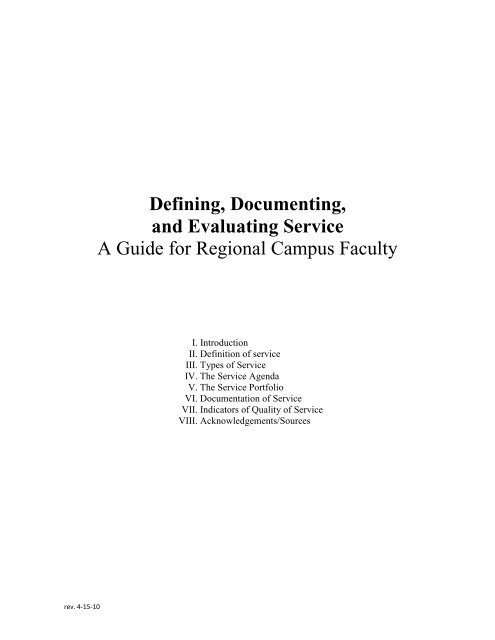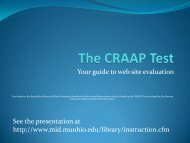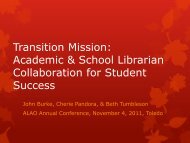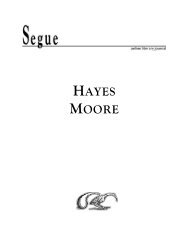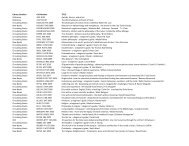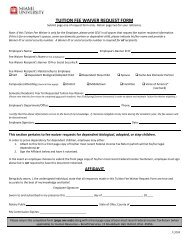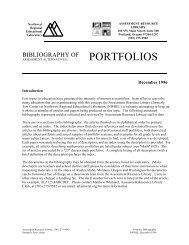Defining, Documenting, and Evaluating Service A ... - Miami University
Defining, Documenting, and Evaluating Service A ... - Miami University
Defining, Documenting, and Evaluating Service A ... - Miami University
Create successful ePaper yourself
Turn your PDF publications into a flip-book with our unique Google optimized e-Paper software.
<strong>Defining</strong>, <strong>Documenting</strong>,<br />
<strong>and</strong> <strong>Evaluating</strong> <strong>Service</strong><br />
A Guide for Regional Campus Faculty<br />
I. Introduction<br />
II. Definition of service<br />
III. Types of <strong>Service</strong><br />
IV. The <strong>Service</strong> Agenda<br />
V. The <strong>Service</strong> Portfolio<br />
VI. Documentation of <strong>Service</strong><br />
VII. Indicators of Quality of <strong>Service</strong><br />
VIII. Acknowledgements/Sources<br />
rev. 4-15-10
I. Introduction<br />
In April 2008 the <strong>University</strong> Senate approved a policy designated “Evaluation of <strong>Service</strong> for<br />
Regional Campus Faculty.” It began this way:<br />
“<strong>Service</strong> plays an important role in the professional lives of all faculty at <strong>Miami</strong>. For<br />
colleagues at Hamilton <strong>and</strong> Middletown, service is especially critical because it can be used as<br />
their second criterion for tenure <strong>and</strong> promotion. More generally, the regional campuses have<br />
an important role to play in their communities that is distinct from Oxford.”<br />
The policy characterized service of four different types (institutional, professional,<br />
community engagement, <strong>and</strong> community outreach). It required faculty who came under its<br />
purview to develop service plans <strong>and</strong> service portfolios in an “intentional <strong>and</strong> strategic”<br />
manner. It also specified that that faculty service in general should “rise to a commensurate<br />
level of intellectual rigor <strong>and</strong> quality as is expected of teaching <strong>and</strong> scholarship,” <strong>and</strong> that<br />
service be evaluated in an systematic manner using “criteria such as the depth of expertise <strong>and</strong><br />
preparation, quality of the work, impact, <strong>and</strong> appropriateness of goals.”<br />
This document elaborates on the directives of that policy <strong>and</strong> attempts to establish a more<br />
detailed common underst<strong>and</strong>ing <strong>and</strong> vocabulary by which faculty service can be described<br />
<strong>and</strong> evaluated.<br />
The criteria for defining, documenting, <strong>and</strong> evaluating the quality of service (parts II, III, VI,<br />
<strong>and</strong> VII of this document) broadly apply to all regional campus faculty for whom service<br />
constitutes an established part of their professional duties. Annual activities reports should<br />
show that service has been significant in terms of the faculty member’s contributions <strong>and</strong> the<br />
service activities’ impact, based on the definitions in this document.<br />
The criteria for service agendas <strong>and</strong> service portfolios (parts IV <strong>and</strong> V of this document) apply<br />
to all regional campus faculty whose tenure-eligible appointment began on or after July 1,<br />
2008, <strong>and</strong> who chose service as their second criterion for tenure <strong>and</strong> promotion. Other faculty<br />
members may elect to be considered under current policy or under the previous policy as it<br />
was set forth in MUPIM, section 7 <strong>and</strong> departmental promotion & tenure guidelines.<br />
II. Definition of <strong>Service</strong><br />
<strong>Service</strong> applies a faculty member’s knowledge, skills, <strong>and</strong> expertise as an educator, a member<br />
of a discipline or profession, or a participant in an institution to benefit students, the<br />
institution, the discipline or profession, <strong>and</strong> the community in a manner consistent with the<br />
missions of the university <strong>and</strong> the campus.<br />
To be evaluated as effective in service, the faculty member needs to document what was<br />
accomplished, what role he or she played in it, <strong>and</strong> its significance or impact.<br />
1
III. Types of <strong>Service</strong><br />
The following four types of faculty service can be documented <strong>and</strong> evaluated:<br />
(1) <strong>Service</strong> to the Institution<br />
(2) <strong>Service</strong> to the Discipline or Profession<br />
(3) Community Engagement<br />
(4) Community Outreach<br />
(1) <strong>Service</strong> to the Institution<br />
Academic programs, departments, schools, the campus, <strong>and</strong> the university as a whole<br />
are not simply organizations but are communities. As such, these communities rely on their<br />
members for the necessary energy, time, <strong>and</strong> leadership to sustain <strong>and</strong> develop them as viable<br />
<strong>and</strong> effective systems for accomplishing their missions. Faculty <strong>and</strong> administrators are<br />
members of these communities who share responsibility for their governance <strong>and</strong><br />
advancement by contributing through institutional service. <strong>Service</strong> to the institution involves<br />
activities that help sustain or lead academic endeavors.<br />
Examples of institutional service include but are not limited to:<br />
• Contributing as a member or leader of a task force to address an issue facing the<br />
campus or university community<br />
• Participating as an elected member in faculty governance<br />
• Leading faculty governance activities<br />
• Serving as an appointed or elected administrator or head of any academic group at<br />
the campus, department, division, or <strong>University</strong> levels<br />
• Chairing a committee<br />
• Helping a committee to meet its goals<br />
• Chairing a search committee<br />
• Contributing to a search committee<br />
• Bringing new campus or university initiatives to fruition<br />
• Representing the university in a public media forum<br />
. • Contributing to student welfare through service on the student-faculty committees or<br />
as adviser to student organizations<br />
(2) <strong>Service</strong> to the Discipline or Profession<br />
<strong>Service</strong> to the discipline or profession involves activities designed to enhance the<br />
quality of disciplinary or professional organizations or activities.<br />
Examples of service to a discipline or profession include but are not limited to:<br />
• Serving as an appointed or elected officer of an academic or professional association<br />
• Serving as an organizer or leader of workshops, panels, or meetings in areas of<br />
professional competence<br />
• Contributing time <strong>and</strong> expertise to further the work of a professional society or<br />
organization<br />
• Promoting the image, prestige, <strong>and</strong> perceived value of a discipline or profession<br />
• Participating in accreditation activities<br />
• Editing a professional journal<br />
2
• Refereeing manuscripts or grant proposals submitted to journals, professional<br />
meeting program committees, <strong>and</strong> funding organizations<br />
• Establishing professional or academic st<strong>and</strong>ards<br />
(3) Community Engagement<br />
Community engagement involves activities that contribute to the public welfare<br />
beyond the university community <strong>and</strong> call upon the faculty member's expertise as scholar,<br />
teacher, or administrator. Community engagement demonstrates the principals of reciprocity<br />
<strong>and</strong> mutuality; it meets a need defined by the community, not merely created out of the<br />
interests of the faculty member.<br />
A faculty member might undertake community engagement independent of teaching<br />
<strong>and</strong> research or integrate them in various ways. For instance, while service-learning is a<br />
pedagogy that most specifically relates to a faculty member’s teaching, if the result is a<br />
project that appropriately combines community need, professional expertise, <strong>and</strong> meaningful<br />
outcomes, then it is community engagement as well. Community engagement may also be<br />
legitimately connected to a faculty member’s research agenda, particularly for publications in<br />
the area of “public scholarship” or the “scholarship of engagement.”<br />
Examples of community engagement include but are not limited to:<br />
• Participating in collaborative endeavors with schools, industry, or civic agencies<br />
• Consulting with private <strong>and</strong> public, profit, <strong>and</strong> not-for-profit organizations by<br />
applying expertise to enhance the efficiency or effectiveness of the organizations served<br />
• Assisting the public through a university clinic, hospital, laboratory, or center<br />
• Providing public policy analysis for local, state, national, or international<br />
government agencies<br />
• Making research underst<strong>and</strong>able <strong>and</strong> useable in specific professional <strong>and</strong> applied<br />
settings<br />
• Communicating in popular <strong>and</strong> non-academic media including newsletters, radio,<br />
television, <strong>and</strong> magazines<br />
• Giving presentations or performances for the public<br />
• Testing concepts <strong>and</strong> processes in real-world situations<br />
• <strong>Evaluating</strong> programs, policies, or personnel for agencies<br />
• Engaging in seminars <strong>and</strong> conferences that address public interest problems, issues,<br />
<strong>and</strong> concerns <strong>and</strong> that are aimed at either general or specialized audiences such as trade,<br />
commodity, practitioner, or occupational groups<br />
• Participating on governmental or social service review panels<br />
• Engaging in economic or community development activities<br />
(4) Community Outreach<br />
Community outreach involves fulfilling a role in the wider community as an active<br />
representative of the campus or university. Volunteerism <strong>and</strong> acts of good citizenship do not<br />
in themselves constitute community outreach unless they are undertaken as part of one’s<br />
professional responsibilities to the institution. The distinction between engagement <strong>and</strong><br />
outreach has primarily to do with the extent to which the activity involves disciplinary<br />
expertise applied to real-world issues (engagement) versus serving as the institution’s<br />
3
epresentative in a community setting (outreach).<br />
Examples of community outreach include but are not limited to:<br />
• Recruiting or informational visits to area high schools<br />
• Civic board memberships where such membership specifically represents university<br />
participation in the organization<br />
• Creation or maintenance of specific <strong>and</strong> directed community outreach efforts<br />
IV. The <strong>Service</strong> Agenda<br />
Faculty should carefully develop, in concert with coordinators, mentors, chairs <strong>and</strong> deans, an<br />
agenda, philosophy <strong>and</strong> plan of service. These plans should be tailored to the specific<br />
professional expertise of the faculty member <strong>and</strong> the needs of the institution <strong>and</strong> the<br />
community. Plans will be flexible <strong>and</strong> open to revision, assuming faculty member,<br />
departmental, <strong>and</strong> campus agreement.<br />
The philosophy/agenda should articulate:<br />
• The purpose of the work <strong>and</strong> its potential value<br />
• The “academic fit” with the faculty member’s expertise (as an educator, as a member<br />
of a discipline or profession, or as participant in the institution)<br />
• Realistic objectives<br />
The construction of a successful service agenda may be a two- or three-year effort <strong>and</strong><br />
typically involves:<br />
• Assessment of the challenges <strong>and</strong> needs within the served community<br />
• Alignment of those needs with the faculty member’s skills <strong>and</strong> knowledge<br />
• Building of relationships <strong>and</strong> opportunities for collaboration<br />
V. The <strong>Service</strong> Portfolio<br />
Faculty members who have service as their second criterion should develop a service portfolio<br />
that documents their activities. In its overall format, the service portfolio is roughly analogous<br />
to the more common teaching portfolio. The latter typically contains a teaching philosophy<br />
followed by materials such as course evaluations, syllabi, sample assignments, representative<br />
student work, peer evaluations, other solicited <strong>and</strong> unsolicited feedback, plus self-reflection<br />
— all aiming to document the faculty member’s effectiveness as a teacher. The service<br />
portfolio should similarly gather <strong>and</strong> organize materials that document the effectiveness of a<br />
faculty member’s service. It should describe <strong>and</strong> contextualize the work, distinguish the<br />
faculty member’s individual contribution, demonstrate the impact of the service work <strong>and</strong><br />
describe the manner in which that impact was assessed. The most successful portfolios<br />
document both process <strong>and</strong> product, show a faculty member’s professional expertise <strong>and</strong><br />
experience as important inputs into the process, <strong>and</strong> display a purposeful approach to service<br />
as part of faculty members’ academic lives.<br />
4
The service portfolio typically begins with a narrative summary of the faculty member’s<br />
service activity that articulates the service philosophy, nature of service <strong>and</strong> the methods<br />
employed, the goals established <strong>and</strong> outcomes achieved, <strong>and</strong> an assessment of its<br />
effectiveness, followed by supporting documentation in the form of appendices (see below,<br />
Section VI).<br />
In some manner, the portfolio should address the following points:<br />
(1) Clear Goals<br />
(2) Adequate Preparation<br />
(3) Appropriate Methods<br />
(4) Significant Results<br />
(5) Effective Presentation<br />
(6) Reflective Critique<br />
(1) Clear Goals<br />
• Does the portfolio state the basic purposes of the work clearly<br />
• Does the portfolio define objectives that are realistic <strong>and</strong> achievable<br />
• Does the portfolio identify important questions in the field<br />
(2) Adequate Preparation<br />
• Does the portfolio show familiarity with scholarship <strong>and</strong> best practices in the area of<br />
service undertaken<br />
• Does the portfolio show the faculty member brought the necessary skills <strong>and</strong><br />
professional background to the work<br />
(3) Appropriate Methods<br />
• Does the portfolio describe methods appropriate to the goals<br />
• Does the portfolio show the methods were effectively applied<br />
(4) Significant Results<br />
• Does the portfolio demonstrate the extent to which the project’s goals were<br />
achieved<br />
• Does the portfolio document the impact of the service work<br />
(5) Effective Presentation<br />
• Does the portfolio use a suitable style <strong>and</strong> effective organization to present the work<br />
• Does the portfolio present its messages with clarity <strong>and</strong> integrity<br />
(6) Reflective critique<br />
• Does the faculty member critically evaluate the work<br />
• Does the faculty member bring an appropriate breadth of evidence to the critique<br />
• Does the faculty member use evaluation to improve the quality of future work<br />
VI. Documentation of <strong>Service</strong><br />
5
Documentation must effectively represent service activities <strong>and</strong> products in a way that enables<br />
evaluators to apply the quality indicators. Types of documentation differ based on the kinds of<br />
service, the constituencies served, the types of products created during the service, <strong>and</strong> other<br />
factors.<br />
Faculty members should consider documentation as an ongoing process, rather than a<br />
summary of outcomes, making it a continuous process with regular feedback from colleagues.<br />
They should focus on documenting their individual contributions while providing context to<br />
the service activity, balancing attention between process <strong>and</strong> impact, clarifying the intellectual<br />
questions that guided the work.<br />
Analytic, reflective, <strong>and</strong> evaluative entries from the following sources may be used to offer<br />
concise <strong>and</strong> effective documentation:<br />
(1) Personal Evaluation<br />
(2) Internal Documentation<br />
(3) External Review<br />
(1) Personal Evaluation<br />
Examples of valued documentation include but are not limited to:<br />
• Reflective critique of process, project outcomes, <strong>and</strong> the alignment of the service<br />
activity with professional <strong>and</strong> career objective of faculty member <strong>and</strong>/or the mission of<br />
institution<br />
(2) Internal Documentation<br />
Examples of valued documentation include but are not limited to:<br />
• Results of any formal assessment or evaluation undertaken of the project<br />
• Minutes of meetings, letters or memos that document processes <strong>and</strong> show the impact<br />
of a faculty member’s service on practices or policies<br />
• Work products or examples used or produced as part of project<br />
• Other artifacts or documents that illustrate the nature of the work or its impact<br />
• Documentation of policy changes or new practices that resulted from the service<br />
(3) External Review<br />
No specific form of external review is required for service. (Note that letters from external<br />
reviewers are still required for the evaluation of research, scholarship <strong>and</strong> creative activity, as<br />
specified in <strong>Miami</strong> <strong>University</strong> Promotion <strong>and</strong> Tenure Guidelines, Part 2, Section IV.)<br />
Examples of valued external documentation of service include but are not limited to:<br />
• Letters or other feedback from clients or sponsors, administrators or colleagues who<br />
engaged in or observed the work, <strong>and</strong>/or external experts in the discipline<br />
• Surveys of clients, community partners or other stakeholders<br />
• Publication in peer-reviewed venue or other dissemination to peers, clients, or the<br />
public<br />
• Media reports or other public recognition of the service work<br />
• Other evidence of impact<br />
6
Examples of unsatisfactory documentation of service<br />
• A simple listing of committees or organizational affiliations<br />
• Assertions of merit based upon time on task rather than specific results<br />
• Evidence of outcomes but no evidence of individual role<br />
• Failure to show how service work is consistent with professional development <strong>and</strong><br />
goals<br />
VII. Indicators of Quality of <strong>Service</strong><br />
Evaluation of the service of tenured <strong>and</strong> probationary faculty for purposes of both<br />
annual review <strong>and</strong> for tenure <strong>and</strong> promotion shall be conducted by persons holding tenure.<br />
The following quality indicators provide faculty members a framework for presenting their<br />
service work <strong>and</strong> enable evaluators to assess the quality of that work. The list of quality<br />
indicators is not exhaustive, nor are the indicators meant to be equally weighted for each<br />
faculty member. Their importance will differ depending on the work being evaluated <strong>and</strong> the<br />
instances of application (i.e., a single service activity or an overall service record).<br />
Indicators of quality of service<br />
(1) Impact/Significance<br />
(2) Intellectual Work<br />
(3) Importance of Role<br />
(4) Communication <strong>and</strong> Dissemination<br />
(5) Interaction of <strong>Service</strong>, Teaching, <strong>and</strong> Research<br />
(1) Impact/Significance is characterized by<br />
• Influencing identified constituencies/creating sustainable change<br />
• Furthering the missions <strong>and</strong> goals of the campus <strong>and</strong> university<br />
• Contributing to the professional development of the faculty member<br />
(2) Intellectual Work is characterized by<br />
• Comm<strong>and</strong> <strong>and</strong> application of relevant knowledge, skills, <strong>and</strong> technological expertise<br />
• Contribution to a body of knowledge<br />
• Imagination, creativity, <strong>and</strong> innovation<br />
• Sensitivity to <strong>and</strong> application of ethical st<strong>and</strong>ards<br />
(3) Importance of role is characterized by<br />
• Consistency in completing necessary work<br />
• Sustained contribution<br />
• Increasing level of responsibility<br />
• Creative <strong>and</strong> responsible leadership<br />
• Consensus building<br />
(4) Communication <strong>and</strong> dissemination is characterized by<br />
• Responsible representation of work during <strong>and</strong> after completion<br />
7
• Communication with appropriate audiences<br />
• Use of modes of communication <strong>and</strong> dissemination appropriate to audiences<br />
• Analysis of <strong>and</strong> reflection on the service<br />
(5) Interaction of <strong>Service</strong>, Teaching <strong>and</strong> Research is characterized by<br />
• Symbiosis of service, teaching, <strong>and</strong> research<br />
• <strong>Service</strong> that contributes to the learning environments for students <strong>and</strong> for faculty<br />
members<br />
All of the quality indicators are relevant to the evaluation of service. A service record that<br />
invites the application of all the quality indicators is more highly valued than one that invites<br />
the application of only isolated quality indicators. For example, the outcome of a service<br />
activity that is widely communicated <strong>and</strong> disseminated, but demonstrates little intellectual<br />
work <strong>and</strong> insignificant impact is less valued than an activity that includes wide dissemination,<br />
intellectual work, <strong>and</strong> significant impact.<br />
VIII. Acknowledgements/Sources<br />
This guide drew significant inspiration, both conceptually <strong>and</strong> for specific ideas <strong>and</strong><br />
phraseology, from:<br />
“<strong>Service</strong> @ Indiana <strong>University</strong>: <strong>Defining</strong>, <strong>Documenting</strong>, <strong>and</strong> <strong>Evaluating</strong>.”<br />
Indianapolis: Center for Public <strong>Service</strong> <strong>and</strong> Leadership, 1999.<br />
Other information <strong>and</strong> ideas were drawn directly or indirectly from:<br />
Glassick, Charles E. <strong>and</strong> Mary Tyler Huber, Gene I. Maeroff. Scholarship Assessed:<br />
Evaluation of the Professoriate. San Francisco: Jossey-Bass, 1997.<br />
Lynton, Ernest A. Making the Case for Professional <strong>Service</strong>. Sterling, Va.: Stylus,<br />
2005.<br />
Driscoll, Amy <strong>and</strong> Ernest A. Linton. Making Outreach Visible: A Guide to<br />
<strong>Documenting</strong> Professional <strong>Service</strong> <strong>and</strong> Outreach. Washington, D.C.: American Association<br />
for Higher Education. 1999.<br />
The basic outline of the regional campus service requirement can be found in:<br />
“Evaluation of <strong>Service</strong> for Regional Campus Faculty.” (Approved by the <strong>University</strong><br />
Senate on April 7, 2008)<br />
8


